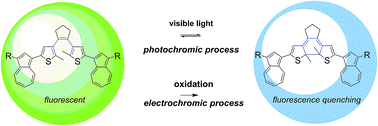Visible-light triggered photoswitching systems based on fluorescent azulenyl-substituted dithienylcyclopentenes†
Abstract
Novel azulenyl functionalized dithienylethenes were synthesized, and their photochromic reactivity, fluorescent and electrochemical properties were investigated. By tailoring the conventional dithienylcyclopentene chromophore with azulene groups, the photocyclization occurred with 405 nm wavelength light irradiation. These compounds exhibited relatively strong fluorescence at 524 nm when excited at 360 nm, which decreased along with the photocyclization. Furthermore, their electrochemical oxidation induced cyclization.


 Please wait while we load your content...
Please wait while we load your content...